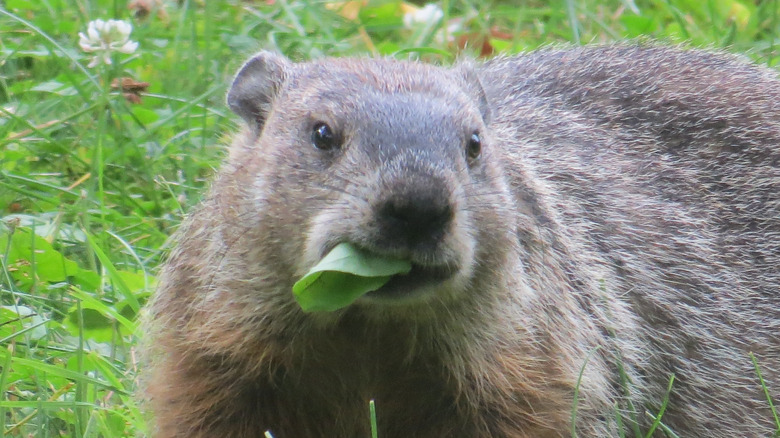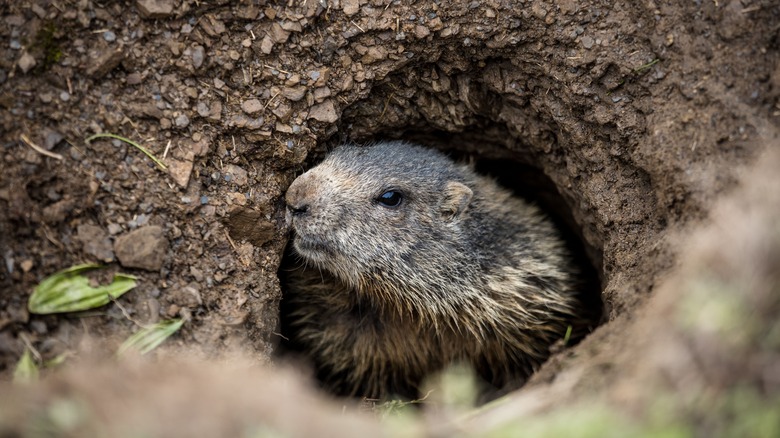How To Stop Groundhogs From Eating Your Kale In The Garden
You take pride in your vegetable garden, especially that lush kale, but there's a good chance you're not the only one admiring it. Groundhogs might also have their eyes (and appetites) set on your greens. It's a common scenario for gardeners: You wait for the perfect harvest time, only to find a groundhog beat you to it. The first thing you can do is harvest your veggies as soon as they're ready. Letting them sit ripe in the garden is like rolling out a welcome mat for these critters.
Now, groundhogs, or woodchucks as some call them, are more than just casual visitors. Their digging can be quite troublesome for your garden's health and aesthetics, and dealing with them is about more than just beating them to the harvest. It's about understanding their habits and making your garden a less inviting place for them. These animals are primarily active during daylight, especially in the early morning or late afternoon. Keeping an eye out during these times might give you a clue about their presence or hideouts. You'll likely have to combine the practice of timely harvesting with other elimination methods, which is key to effectively keeping groundhogs out of your garden.
Evicting groundhogs from your garden
So, you've noticed that groundhogs have taken a liking to your kale despite your best efforts at timely harvesting. It's clear that more direct action is needed. Eviction can be an effective method for dealing with groundhogs; let's talk about how you can do this safely. The process starts with locating their burrows. Groundhogs typically create a network of tunnels and burrows, often with several entrances. Your first task is to identify these entrances. You can do this by looking for mounds of dirt; these are usually the telltale signs of a groundhog's burrow.
Once you've located the burrows, test to see if they're active. A simple way to do this is by loosely plugging all the entrances with easily moveable materials, like grass clippings. Keep an eye on these plugs over the next three to five days. If you find that the plugs have been disturbed, indicating that the burrow is occupied, it's time to gently persuade the groundhogs to move out. Try placing a smelly deterrent, like used kitty litter, inside the entrance. The idea is to make the burrow less appealing without harming the animals. Try to keep the smell contained by closing off the entrance to reduce airflow. If activity ceases, you can go ahead and close the burrow. Use dirt, rocks, or a combination of materials to ensure that the groundhogs can't easily reopen the entrance.
A fence is a solid line of defense against groundhogs
If eviction alone hasn't solved your groundhog problem, it's time to consider building a garden fence to keep these persistent critters away from your kale. Yes, it does require some effort, but the peace of mind and protection it offers your garden are well worth it. The fence should be made of sturdy chicken wire or hardware cloth. Opt for one with a mesh size of around 3 inches square, which is small enough to prevent groundhogs from squeezing through.
The height of the fence is also important. It needs to be above ground level by at least 4 feet to deter groundhogs from climbing over it. And since groundhogs are skilled diggers, your fence also needs an underground barrier. An L-footer base, which is essentially a bend at the bottom of the fence that extends outward, is highly effective. This extension should be at least a foot wide and buried a few inches below the surface to prevent digging. Angle a small part of the fence's top edges outward at 45 degrees. This angled overhang makes it even more difficult for groundhogs to climb over the fence and access your kale.
Regular maintenance of your fence is also key. Inspect it periodically for any signs of damage or wear and make repairs as needed. Also, keep the area around the fence clear of tall grass and debris to reduce the attractiveness of your garden to groundhogs.


